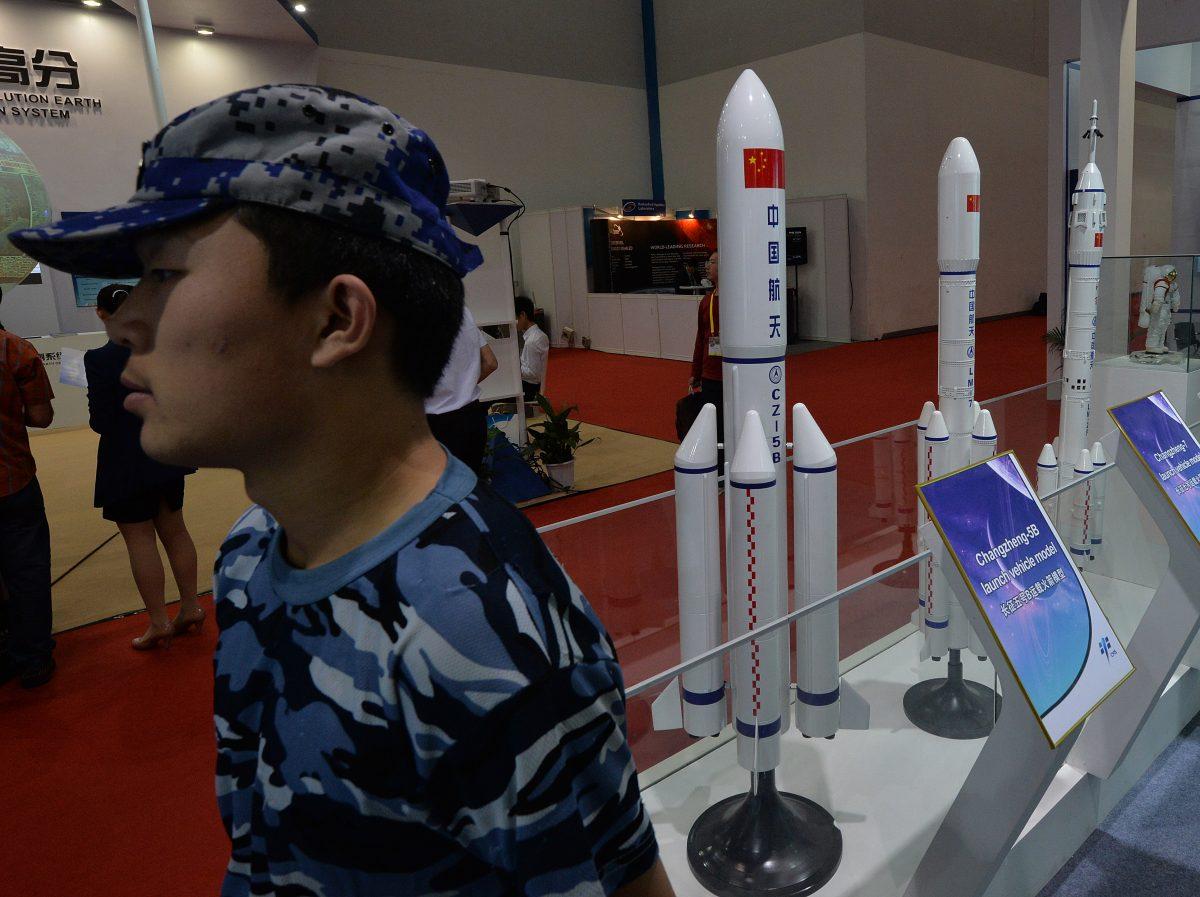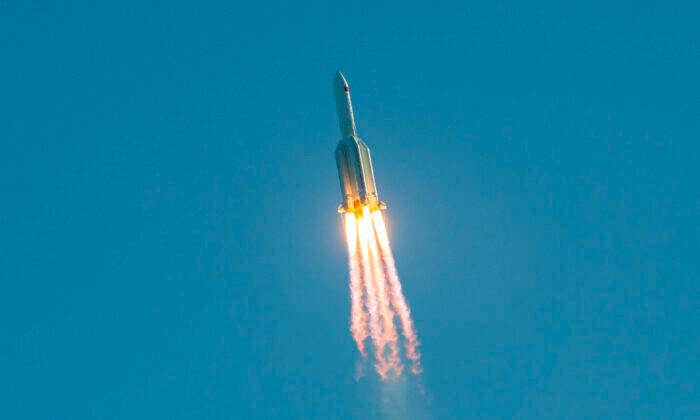When China tested its fractional orbital bombardment system (FOBS) nuclear delivery weapon in July 2021 and August 2021, it said nothing about its plans for developing this weapon.
First produced by the former Soviet Union in the late 1960s to better evade the U.S. early warning radar, China’s FOBS can do that but could also evolve into a potent space weapon.
Two recent Chinese revelations may indicate that China intends to build a robust FOBS capability that could include various liquid- and solid-fueled launchers, large and small warhead dispensing “buses,” and exploitation of launch opportunities from multiple axes on the globe.
Early in the U.S.–Soviet intercontinental ballistic missile (ICBM) competition, the Soviets decided that they needed to evade early U.S. and Canadian ballistic missile early warning (BMEW) radar that, despite the curvature of the Earth over the Arctic, could provide useful warning of Soviet ICBMs that could fly at altitudes of more than 1,000 miles over their ballistic arcs.
But in the mid to late 1960s, Soviet designers such as Sergei Korolev and Mikhail Yangel had developed ICBMs that would place a warhead bus into low Earth orbit (125 to 300 miles), but go the opposite direction and strike U.S. targets with southern approaches not defended by BMEW radar. The bus would then use thrusters to decelerate to allow strikes with nuclear warheads.
For its July 2021 and August 2021 test flights, China used a 1980s vintage workhorse satellite-lofting China Aerospace Science and Technology Corporation (CASC) Long March-2C space launch vehicle but equipped with a new final stage “bus” that also circled the Earth on a South Polar trajectory over Antarctica.
It’s very likely that the Chinese FOBS bus decelerated before launching a hypersonic glide vehicle (HGV) warhead at a target in China. HGVs are maneuverable and can exploit long and low trajectories to “sneak up on” a target.
Older, reliable liquid-fuel launchers such as the Long March-2C can loft warhead-dispensing FOBS buses that can circle the Earth for months before a conflict. This gives the Chinese regime the option of multi-axis, devastating nuclear first strikes or surprise nonnuclear attacks against targets on land or at sea.
But Chinese rocket companies such as CASC and the China Aerospace Science and Industry Corporation (CASIC), in addition to new “private” space launch vehicle (SLV) companies, offer great potential for developing more mobile solid-fuel FOBS platforms.

These range from the massive CASIC solid fuel Kuaizhou-31, which can loft 70-ton payloads into orbit, to the smaller CASC Jielong-3—based on the DF-41 ICBM—which can loft 1.5 tons to a 300-mile orbit.
The Jielong-3 has been used to launch surveillance satellites of the new Hong Kong Aerospace Technology Group (HKATG), which on Jan. 9 announced, with Djibouti’s President Ismail Omar Guelleh, their initialing of a $1 billion deal to build a space launch facility with up to seven space launch platforms by 2028. This would be China’s first foreign-deployed space launch base.
But just to be sure the world didn’t conclude that Djibouti would be allowing China to launch nuclear weapons, on the very same day, the authoritarian Guelleh government signed the U.N. Treaty on the Prohibition of Nuclear Weapons.
Now China doesn’t adhere to this treaty, and even as a “private” company, HKATG would have to obey Chinese “civil-military fusion” regulations that would oblige it to follow Chinese government and military orders.
As it has never before conducted space launches, perhaps HKATG will rely heavily on help from the People’s Liberation Army Strategic Support Force, which controls China’s five other space launch bases and the People’s Liberation Army’s (PLA’s) manned and unmanned space assets and is likely the lead PLA service for space warfare—perhaps to include bombing the Earth from space.
Since 2017, China has maintained naval and air facilities in Djibouti, stationing about 2,000 troops there, armed with the potent ZTL-11 wheeled tank; the United States maintains more than 4,000 troops nearby in Camp Lemonnier in Djibouti.
It’s unlikely that increasingly China-dependent Guelleh will raise a real fuss if Beijing wants to launch “civilian” Jielong-3 SLVs that are covertly armed with a FOBS bus that could carry at least one hypersonic glide vehicle weapon.
From Djibouti, a South Polar trajectory over Antarctica sets up a FOBS bus for strikes against U.S. bases in Alaska or U.S. ICBM bases in North Dakota, Montana, and Wyoming.
That China’s FOBS buses have the most accurate guidance information will now be better ensured by Beijing’s second revelation, made in a Feb. 2 article in the Chinese publication China Space News, that CASIC will build a space tracking and control (STC) facility at China’s Zhongshan Research Station in Antarctica.
The United States, Norway, and Germany also maintain STC facilities in Antarctica. Still, they don’t have FOBS weapons as China does, and the CASIC STC in Antarctica is also likely to be directly controlled by the Strategic Support Force (SSF).
China’s Zhongshan STC likely won’t just be helping guide FOBS strikes against the United States; it’s also ideally placed to support SSF-controlled expansion of China’s manned presence on the moon.
The Zhongshan STC will also help the SSF to conduct space warfare. In a Feb. 19, 2021, article, Chinese state-run media outlet Xinhua reported that Chinese researchers had installed a “fluorescence doppler lidar system” at Zhongshan for atmospheric research; lidar is laser radar.
Many of the low Earth orbit surveillance satellites of the United States, the UK, France, Japan, and Taiwan are polar orbiters that pass over Antarctica multiple times per day.
There’s a good chance that since 2021, China’s research lidar at Zhongshan has grown larger—into the kind of laser weapon that the regime began using about 20 years ago to harass and damage U.S. satellites.
As the ozone is much thinner over Antarctica, a laser weapon based there will be able to do much more damage to overhead satellites, which also tend to fly closer to the Earth over the poles.
All of this points to the necessity for the United States to consider the rapid development of its own FOBS weapons to deter the Chinese regime, which, for decades, has rejected all arms control approaches that would limit its nuclear weapons.
It also points to the need for the United States to engage Australia and New Zealand to consider how the ANZUS (Australia–New Zealand–United States) allies can better ensure that they can stop Chinese military usage of Antarctica, either by non-kinetic or kinetic means.






Friends Read Free